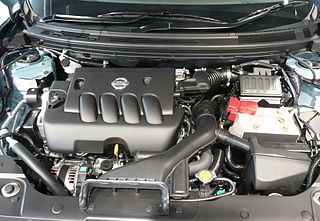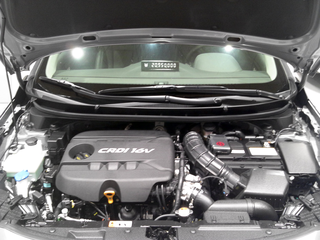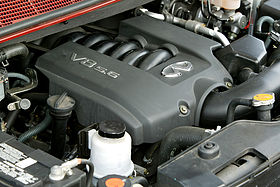
The Northstar engine is a family of high-performance 90° V engines produced by General Motors between 1993 and 2011. Regarded as GM's most technically complex engine, the original double overhead cam, four valve per cylinder, aluminum block/aluminum head V8 design was developed by Oldsmobile R&D, but is most associated with Cadillac's Northstar series.

The Ford Modular engine is Ford Motor Company's overhead camshaft (OHC) V8 and V10 gasoline-powered small block engine family. Introduced in 1990, the engine family received its “modular” designation by Ford for its new approach to the setup of tooling and casting stations in the Windsor and Romeo engine manufacturing plants.

The Jaguar AJ-8 is a compact DOHC V8 piston engine used in many Jaguar vehicles. It was the fourth new engine type in the history of the company. It was an in house design with work beginning before Ford's purchase of the company. In 1997 it replaced both designs previously available on Jaguar cars: the straight-6 Jaguar AJ6 engine, and the Jaguar V12 engine. It remained the only engine type available on Jaguar until 1999 with the launch of the S-Type, when the Jaguar AJ-V6 engine was added to the list. The AJ-V8 is available in displacements ranging from 3.2L to 5.0L, and a supercharged version is also produced. Ford Motor Company also used this engine in other cars, including the Lincoln LS and the 2002–2005 Ford Thunderbird, as well as in several Land Rovers, and the Aston Martin V8 Vantage.

The VH series consists of 4.1 and 4.5 litres engines built from 1989 to 2001 by the Nissan Motor Corporation. The design consists of a 90-degree V8 with an aluminium cylinder block that features a closed upper deck and a deep skirt. The cylinder heads are also aluminium with a DOHC 4 valves design and pentroof combustion chambers. The production blocks and production head castings were used successfully in various forms of racing including the IRL.

The VQ is a family of V6 automobile petrol engines developed by Nissan and produced in displacements varying from 2.0 L to 4.0 L. Designed to replace the VG series, the all-aluminium 4-valve per cylinder DOHC design debuted with Nissan's EGI/ECCS sequential multi-point fuel injection (MPFI) system. Changes from the VG engine include switching to a timing chain from a timing belt, and relocating the water pump from the outside of the engine to inside the timing cover where the pump is driven by the timing chain. Later versions featured various improvements, such as variable valve timing, and NEO-Di designated VQ engines replace MPFI with direct fuel injection.

The RB engine is an oversquare 2.0–3.0 L straight-6 four-stroke gasoline engine from Nissan, originally produced from 1985 to 2004. The RB followed the 1983 VG-series V6 engines to offer a full, modern range in both straight or V layouts.

The VG engine is a family of V6 engines designed and produced by Nissan between 1983 and 2004.

The QR family of inline-four piston engines by Nissan were introduced in 2000 and range from 2.0 to 2.5 L in displacement. These motors are aluminum, dual overhead camshaft (DOHC), four-valve designs with variable valve timing and optional direct injection. The engine shares much of its architecture with the YD diesel engine.

The QG engine is a 1.3 L (1,295 cc), 1.5 L (1,497 cc), 1.6 L (1,597 cc) and 1.8 L (1,769 cc) straight-4 piston engine from Nissan. It is a lean-burn aluminum DOHC 4-valve design with variable valve timing and optional NEO Di direct injection.

The SR engine is a series of 1.6 L (1,596 cc), 1.8 L (1,838 cc) or 2.0 L (1,998 cc) straight-four, four-stroke gasoline engines manufactured by Nissan. It has an aluminium head and block with steel sleeves and has a DOHC 4-valve design, with variable valve timing on select models.

The GA engine is a 1.3 to 1.6 L inline-four piston engine from Nissan. It has a cast-iron block and an aluminum head. There are SOHC and DOHC versions, 8, 12, and 16 valve versions, carbureted, single-point, and multi-point injected versions, and versions with variable valve timing (GA16DE). The GA was produced from August 1987 through 2013. Since 1998, it was only available from Mexico in the B13.

The 6G7 series or Cyclone V6 engine is a series of V6 piston engines from Mitsubishi Motors. Five displacement variants were produced from 1986 to 2021, with both SOHC and DOHC, naturally aspirated and turbo charged layouts. While MIVEC variable valve timing has also been implemented in some versions the 2.5, 3.0, and 3.5 L versions were also available with gasoline direct injection. This engine has been the flagship powerplant of the company except when they briefly built a V8 in 1999–2001. The staple of their high-end sedans, it was given twin-turbos for the Mitsubishi GTO, and became the most powerful car ever built by the company at the time.

The Toyota UZ engine family is a gasoline fueled 32-valve quad-camshaft V8 piston engine series used in Toyota's luxury offerings and sport utility vehicles. Three variants have been produced: the 1UZ-FE, 2UZ-FE, and 3UZ-FE. Production spanned 24 years, from 1989 to mid 2013, ending with the final production of the 3UZ-FE-powered Toyota Crown Majesta I-FOUR. Toyota's UZ engine family was replaced by the UR engine family.

The Nissan L series of automobile engines was produced from 1966 through 1986 in both inline-four and inline-six configurations ranging from 1.3 L to 2.8 L. It is a two-valves per cylinder SOHC non-crossflow engine, with an iron block and an aluminium head. It was the engine of the Datsun 510, Datsun 240Z sports car, and the Nissan Maxima. These engines are known for their reliability, durability, and parts interchangeability.

The Renault-Nissan MR engine family consists of straight-four 16-valve all-aluminium and water cooled automobile engines with variable valve timing co-developed by Renault and Nissan. Renault calls it the M engine. Other noteworthy features of this engine family include acoustically equal runner lengths and a tumble control valve for the intake manifold, a "silent" timing chain, mirror finished crankshaft and camshaft journals, and offset cylinder placement in an attempt for increased efficiency.

The HR is a family of straight-3 12-valve and straight-4 16-valve automobile engines with continuously variable valve timing, involving development by Nissan and/or Renault, and also Mercedes-Benz in the case of the H5Ht/M282. The designation of H engine is used by Renault, and M28x by Mercedes-Benz, to classify the family. There are three basic specifications of engine involving variations in engine architecture, or all-new architecture, with 72.2 mm (2.84 in), 75.5 mm (2.97 in) and 78 mm (3.07 in) bore diameter.

The VR is a series of twin-turbo DOHC V6 automobile engines from Nissan with displacements of 3.0 and 3.8 L. An evolution of the widely successful VQ series, it also draws on developments from the VRH, JGTC, and Nissan R390 GT1 Le Mans racing engines.

The Hyundai U engine is a series of three or four-cylinder diesel engines made for automotive applications by the Hyundai Kia Automotive Group. The U series of engines includes the smallest automotive diesel engines produced by Hyundai.

The Nissan VRH engine family consists of several racing engines built by Nissan Motor Company beginning in the late 1980s. All VRH engines are in a V8 configuration, with either natural aspiration or forced induction. Some VRH engines are loosely based on Nissan's production V8 engine blocks, including the VH and VK engines, while others were designed from the ground up for racing and share no components with production blocks.























